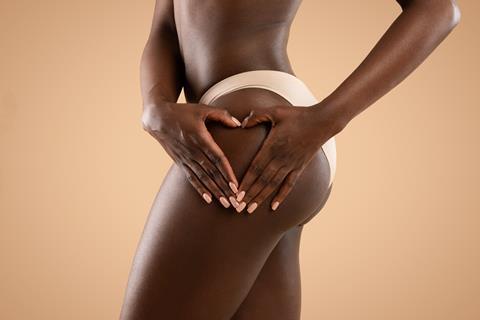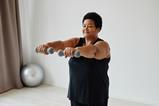Bukky Ayoade explains what happens to the pelvic floor during perimenopause and menopause, and gives advice on how to avoid uncomfortable symptoms

While hot flushes and night sweats are possibly the most discussed symptoms of menopause, a lesser-mentioned aspect is its impact on pelvic health. The group of muscles known as the pelvic floor play a crucial role in bladder control, sexual function and overall wellbeing. During menopause these muscles can weaken, leading to a range of uncomfortable symptoms. Here, I share some insight into this and what we can do to look after our pelvic health in midlife.
How menopause affects pelvic health
As oestrogen plays a key role in our urinary and reproductive systems, a deficiency of oestrogen during perimenopause and menopause causes the lining of the bladder and urethra to become thinner and the pelvic floor muscle and rectum to get weaker. This can lead to problems, some of which are listed below.
Stress incontinence This is when there is a leak of urine because of coughing, laughing, sneezing or running. Overactive bladder is a frequent or constant need to wee. Urge incontinence is a desperate feeling of needing to go to the toilet without much warning – when you simply can’t hold on and you leak.
Pelvic organ prolapse A prolapse happens when the muscles and ligaments of your pelvic floor are weakened and just give way and so one or more organs in the pelvis slip and bulge into the vagina. It can feel like something is falling out of your vagina, a heavy feeling or like sitting on an egg or a ball.
Prolapse from constipation Constipation causes more straining than usual. This extra pressure can push on the back wall of the vagina, causing it to bulge inward causing a type of prolapse called a rectocele. Constipation can also lead to haemorrhoids.
Urinary tract infections (UTIs) A decline in oestrogen levels during perimenopause and menopause can contribute to alterations in the vaginal and urethral bacteria. Reduced oestrogen can lead to a decrease in these beneficial bacteria, potentially increasing susceptibility to UTIs. Furthermore, the decline in oestrogen can directly impact the bladder and surrounding tissues, causing irritation and symptoms that mimic a UTI even in the absence of bacterial infection.
Vaginal changes There can be a thinning and loss of elasticity in the vaginal walls, along with a decrease in natural lubrication. The consequences of these include pain during sex, discomfort when inserting tampons, increased susceptibility to UTIs and other urinary symptoms such as urgency or frequency. Additionally, vulvar itching and soreness are common.
As you can imagine, experiencing any of these is unpleasant and so it is good to be aware of the effects of menopause on our pelvic floor so that we can prioritise pelvic health.
Resources
If you do experience pelvic issues or are concerned about anything in relation to your pelvic health, I would recommend you speak with your healthcare professional in the first instance as you may need a referral to a specialist pelvic health practitioner. Here are number of resources that may also prove useful:
1. NHS explanation of pelvic floor exercises: nhs.uk/common-health-questions/lifestyle/what-are-pelvic-floor-exercises
2. Women’s health concern factsheets: Prolapse: womens-health-concern.org/wp-content/uploads/2022/12/21-WHC-FACTSHEET-Prolapse-NOV2022-B.pdf
Urogenital Problems: womens-health-concern.org/wp-content/uploads/2023/11/23-WHC-FACTSHEET-UrogenitalProblems-OCT2023-B.pdf
3. Female incontinence resources: yourpelvicfloor.org/leaflets
4. Recent BBC programme – My Prolapse and Me on iPlayer: bbc.co.uk/programmes/p0h0qqzr
5. Squeezy: an app to help you manage your pelvic health: squeezyapp.com
6. The Pelvic Pain Network: online, bespoke pelvic health physiotherapy (I recently met the founders – they are amazing): pelvicpainnetwork.co.uk
Taking care of your pelvic health
Here are some ways to strengthen and improve your pelvic health.
Pelvic floor exercises (Kegels) When done correctly, these exercises can strengthen the muscles surrounding the vagina, urethra and rectum, potentially improving symptoms. However, it’s crucial to perform them correctly to avoid worsening the condition. A pelvic floor therapist can offer guidance and ensure you’re engaging the right muscles effectively. Tools like sensors or home devices can also assist with proper technique. I recommend consulting with a specialist before starting any exercise regime.
Lifestyle changes Maintaining a healthy weight, managing chronic coughs or constipation and staying hydrated can all contribute to pelvic health. Prioritise bowel health by drinking plenty of water throughout the day and ensure a diet rich in fibre. Fibre helps soften stools, makes it easier to go to the toilet and reduces the need for straining.
Hormone replacement therapy (HRT) For some women, HRT with low-dose oestrogen may be an option to address symptoms like vaginal dryness and improve overall pelvic health. However, this is a personal decision that should be discussed with a healthcare professional.
There are options for managing our pelvic health and continuing to live active, healthy lives
I have experienced stress incontinence and the vaginal changes. So now I ‘squeeze’ my pelvic floor muscles at intervals throughout the day to strengthen them. I also used to experience frequent UTIs until I realised this was a menopause symptom, so I changed all my vaginal products washes, panty liners, toilet roll. I make sure I don’t use anything fragranced down below. I personally use an aqueous cream wash and the ‘YES®’ brand of vaginal moisturisers, which have given me great relief.
Pelvic issues during menopause can be unpleasant, impact our confidence and affect our relationships and quality of life. So, it is essential we gain pelvic health awareness and find strategies and treatments available to manage our own pelvic health. Whether it’s through hormonal therapies, pelvic floor exercises or other treatments, there are options for managing our pelvic health and continuing to live active, healthy lives.
Bukky Ayoade is menopause lead at NHS England, a pharmacist and certified health/wellness coach to midlife women. To find out more about Bukky and the resources she offers, visit vibrantmidlife.com
Heading to a festival this summer?
If you are planning on attending a summer festival, it’s important to prioritise your pelvic health amid the festivities. Be mindful of staying hydrated to prevent urinary tract infections; balancing this with not having to go to the loo every second could be tricky, but awareness is key to help you plan a winning strategy. Take breaks from prolonged sitting or standing to alleviate pressure on your pelvic floor, and consider wearing comfortable, supportive footwear to maintain proper posture. Additionally, be cautious of consuming excessive alcohol, as it can exacerbate pelvic floor issues. By taking proactive measures and listening to your body’s needs, you can enjoy the festivals while safeguarding your pelvic health.

































No comments yet